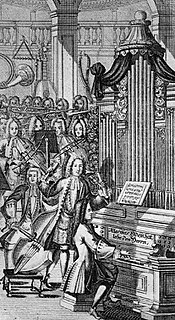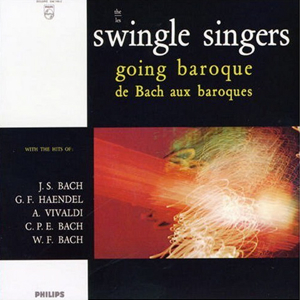
Trevor David Pinnock is a British harpsichordist and conductor.

The Swingles are a vocal group formed in 1974 in England by Ward Swingle. The group replaced Swingle's earlier "Swingle Singers", formed in 1962 in Paris, France with Anne Germain, Claude Germain, Jeanette Baucomont, Christiane Legrand, Claudine Meunier, Jean-Claude Briodin, and Jean Cussac.
The Concerto for Two Violins in D minor, BWV 1043, also known as the Double Violin Concerto, is a violin concerto of the Late Baroque era, which Johann Sebastian Bach composed around 1730. It is one of the composer's most successful works.

L'estro armonico, Op. 3, is a set of 12 concertos for stringed instruments by Italian composer Antonio Vivaldi, first published in Amsterdam in 1711. Vivaldi's Twelve Trio Sonatas, Op. 1, and Twelve Violin Sonatas, Op. 2, only contained sonatas, thus L'estro armonico was his first collection of concertos appearing in print. It was also the first time he chose a foreign publisher, Estienne Roger, instead of an Italian. Each concerto was printed in eight parts: four violins, two violas, cello and continuo. The continuo part was printed as a figured bass for violone and harpsichord.

The keyboard concertos, BWV 1052–1065, are concertos for harpsichord, strings and continuo by Johann Sebastian Bach. There are seven complete concertos for a single harpsichord, three concertos for two harpsichords, two concertos for three harpsichords, and one concerto for four harpsichords. Two other concertos include solo harpsichord parts: the concerto BWV 1044, which has solo parts for harpsichord, violin and flute, and Brandenburg Concerto No. 5 in D major, with the same scoring. In addition, there is a nine-bar concerto fragment for harpsichord which adds an oboe to the strings and continuo.
An organ concerto is a piece of music, an instrumental concerto for a pipe organ soloist with an orchestra. The form first evolves in the 18th century, when composers including Antonio Vivaldi, Johann Sebastian Bach and George Frideric Handel wrote organ concertos with small orchestras, and with solo parts which rarely call for the organ pedal board. During the Classical period the organ concerto became popular in many places, especially in Bavaria, Austria and Bohemia, reaching a position of being almost an integral part of the church music tradition of jubilus character. From the Romantic era fewer works are known. Finally, there are some 20th- and 21st-century examples, of which the concerto by Francis Poulenc has entered the basic repertoire, and is quite frequently played.

Herr, gehe nicht ins Gericht mit deinem Knecht, BWV 105 is a church cantata by Johann Sebastian Bach. He composed it in Leipzig for the ninth Sunday after Trinity and first performed it on 25 July 1723. The musicologist Alfred Dürr has described the cantata as one of "the most sublime descriptions of the soul in baroque and Christian art".

Going Baroque is the second album released by the Paris-based Swingle Singers. The album was a 1964 Grammy award winner for "Best Performance by a Chorus."

Anyone for Mozart? is the third album released by the Swingle Singers. The album was a 1965 Grammy award winner for "Best Performance by a Chorus."

Anyone for Mozart, Bach, Handel, Vivaldi? is a CD compilation re-issue of music by the Swingle Singers. It combines tracks from two previous LP releases, Going Baroque and Swinging Mozart.

Back to Bach is a 1968 album released by the Paris-based Swingle Singers.

Jazz Sebastian Bach is a compilation album / re-issue of music by the Paris-based Swingle Singers. It combines the tracks from two previous releases, 1963's Bach's Greatest Hits a.k.a. Jazz Sébastien Bach with 1968's Back to Bach a.k.a. Jazz Sébastien Bach Vol. 2.

Rococo Á Go Go is the fifth album released by the Swingle Singers. The album was nominated for a 1966 Grammy award.

The 2005 Philips boxed set, Swingle Singers is a compilation of all eleven of the Paris-based Swingle Singers' recordings made for Philips between 1963 and 1972. Ten of the eleven disks included in this boxed set had also been re-issued previously by Philips (Emarcy) in five "two-fer" compilation sets over the preceding five years.
A double concerto is a concerto featuring two performers—as opposed to the usual single performer, in the solo role. The two performers' instruments may be of the same type, as in Bach's Double Violin Concerto, or different, as in Brahms's Concerto for Violin, Cello and Orchestra.
Sei Lob und Ehr dem höchsten Gut, BWV 117, is a church cantata by Johann Sebastian Bach. He composed the chorale cantata in Leipzig between 1728 and 1731 for no specific occasion, based on the hymn by Johann Jacob Schütz.
Ich steh mit einem Fuß im Grabe, BWV 156, is a church cantata by Johann Sebastian Bach. He composed it in Leipzig for the third Sunday after Epiphany and first performed it on 23 January 1729. The cantata is well known for its opening sinfonia for orchestra and oboe solo.
The organ concertos of Johann Sebastian Bach are solo works for organ, transcribed and reworked from instrumental concertos originally composed by Antonio Vivaldi and the musically talented Prince Johann Ernst of Saxe-Weimar. While there is no doubt about the authenticity of BWV 592–596, the sixth concerto BWV 597 is now probably considered to be spurious. Composed during Bach's second period at the court in Weimar (1708–1717), the concertos can be dated more precisely to 1713–1714.
Antonio Vivaldi composed several settings of the Dixit Dominus, the Latin version of Psalm 110. They include a setting in ten movements for five soloists, double choir and orchestra, RV 594, another setting in eleven movements for five voices, five-part choir and orchestra, RV 595, and a recently discovered setting in eleven movements for five soloists, choir and orchestra, RV 807, which had been attributed to Baldassare Galuppi. It is said to be one of his "most significant sacred works."












